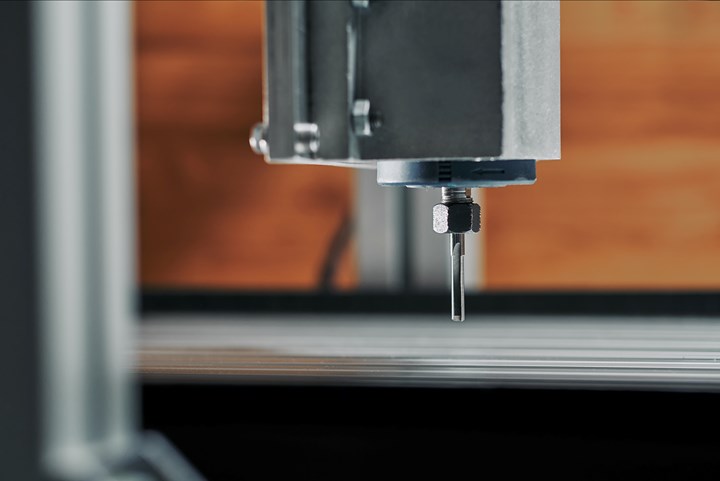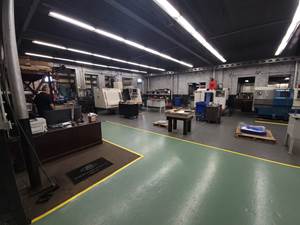Five Safety Considerations for CNC Machinists
Safety in CNC environments is essential for users – and for productivity. Consider these 5 points to avoid injury, part failure and downtime.
The most dangerous time for a CNC user is when a cutting tool approaches for the first time. Consistently programming rapid approach movements is one way to promote CNC safety. Photo: Getty Images
Safety issues directly affect the productivity of any CNC environment. Optimum productivity can only be achieved when G-code programs are safe to run in three ways. First, programs must ensure that operators work in a secure environment. Second, programs must ensure that machine tools, workholding devices and cutting tools are not stressed or damaged. And third, programs must machine acceptable workpieces. Injured operators or damaged machines and components result in productivity-killing downtime. Scrapping parts results in wasted time. Any of these result in higher operating costs.
There are many safety-related actions that G-code programs must follow, as well as certain things they must not do. Below are five suggestions aimed at keeping CNC people and machines safe while facilitating the machining of quality workpieces.
1. Avoid overly aggressive cutting conditions and insufficient workholding and support
While these issues may not be directly related to the G-code program, they are a function of the process used to create the program. Machining pressures caused by the dynamics of machining operations must not exceed the machine’s or workholding device’s ability to handle the programmed machining operations.
2. Don’t allow a bar to hang out from the spindle
This issue is also more related to application and process than it is to G-code programming. Many companies use bar feeders to machine multiple workpieces from a long bar. Indeed, bar-feeding is a common application for CNC lathes. With a bar feeder, the long bar — possibly as long as 15 feet (5 m) — is completely enclosed in the bar feeder. This provides adequate support for the bar.
There are companies that do not have many applications for bar feeding. When they do come across a bar-feeding job, they instead use a bar puller. A special tool in the turret is used to pull the bar during the bar “feed.” With these applications, ensure that the bar never extends past the spindle end at the back of the machine. If it does, even by a small amount, the portion hanging out will be unsupported. When the spindle accelerates to machining speeds, the internal pressures in the bar will cause it to instantly bend to ninety degrees at the spindle. This bent-over portion of the bar may shear from the bar and be thrown into the shop area. Or it may remain attached. But either way, it will likely cause severe damage to the machine and injuries to people that happen to be in the area.
3. Use M code for rotary axis clamping
Most rotary axes incorporate a clamp that can be used during powerful machining operations. Once in position, if the clamp (commonly commanded with an M code) is not engaged, the rotary axis components (drive motor, worm gear, and so on) will bear the full pressure of the machining operation. Over time, this will cause the related components to prematurely wear out. For any machines that have rotary axes (for example, mills or lathes), find out if it has a clamp and, if so, which M codes are involved.
4. Watch hand of cutting tools for turning centers
This will not be of concern for those who run free-machining materials (such as aluminum or wax) or perform shallow cuts (like finishing operations). For powerful operations (such as rough boring, turning or facing), be sure to use the hand of tooling that causes the force of the machining operation to be absorbed by the bed and way systems of the machine, or else the machining operation forces will tend to pull the machine components apart, causing play in the way systems. Over time, the machine will develop chatter and sizing issues.
5. Ensure safe rapid approach motion
The most dangerous time for a CNC user is when a cutting tool approaches for the first time. It will be moving at the machine’s rapid rate to a position that is very close to the work surface. Most programmers use a rapid approach distance of 0.1 in (about 2.5 mm) — some even closer.
First of all, be sure the CNC people know how to take control of the rapid approach moment. This commonly involves the use of single block, feed hold, rapid override (or possibly dry run) and the distance-to-go screen. By one means or another, the setup people and operators must have a way to make the machine crawl during each tool’s first approach to the work surface.
Additionally, be consistent when programming rapid approach movements so setup people and operators will always know how the machine will approach. For machining centers, I recommend first moving the tool into position in the x and y axes. Then approach in the z axis. This way, there is only one axis to deal with. Also, initially position the cutting tool 1.0 in (25.0 mm) above the work surface. Then position it to the work surface. When in single block mode, the operator can then rest assured, knowing the tool will stop an inch above the work surface.
Even with these suggestions, CNC users must be vigilant in identifying potential issues. Use past experience as a guide; think through safety issues the company has had over the years and consider whether acceptable remedies have been applied. And whenever a mishap occurs, of course, take action to ensure that it never happens again.
Related Content
From Tradition to Transformation: Century-Old Manual Machine Shop Adds CNCs
After 122 years of working with manual mills and lathes, this fifth-generation shop acquired assets of a local CNC machining business and hired the owner. Here’s how it’s going a year later.
Read More4 Commonly Misapplied CNC Features
Misapplication of these important CNC features will result in wasted time, wasted or duplicated effort and/or wasted material.
Read More6 Machine Shop Essentials to Stay Competitive
If you want to streamline production and be competitive in the industry, you will need far more than a standard three-axis CNC mill or two-axis CNC lathe and a few measuring tools.
Read MoreFive-Axis Machines Speed NASCAR Engine Production
Moving from an aging set of five-axis mills to more advanced machines enabled Hendrick Motorsports to dramatically improve its engine production.
Read MoreRead Next
5 Rules of Thumb for Buying CNC Machine Tools
Use these tips to carefully plan your machine tool purchases and to avoid regretting your decision later.
Read MoreRegistration Now Open for the Precision Machining Technology Show (PMTS) 2025
The precision machining industry’s premier event returns to Cleveland, OH, April 1-3.
Read MoreRego-Fix’s Center for Machining Excellence Promotes Collaboration
The new space includes a showroom, office spaces and an auditorium that will enhance its work with its technical partners.
Read More
.jpg;width=70;height=70;mode=crop)










.jpg;maxWidth=300;quality=90)















